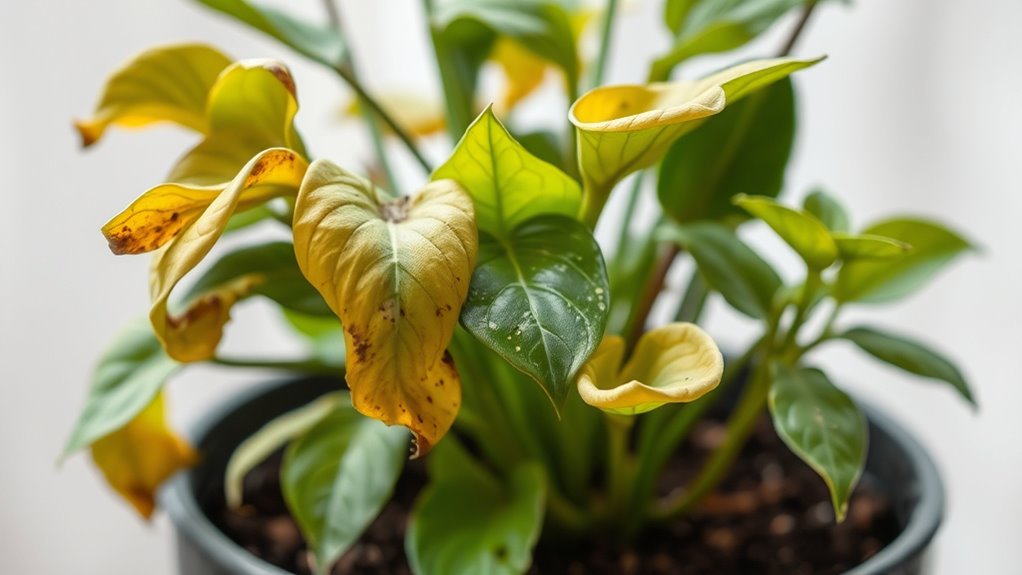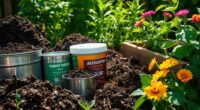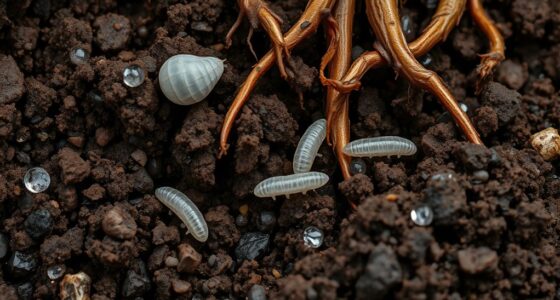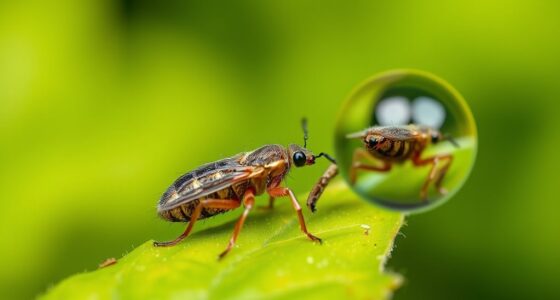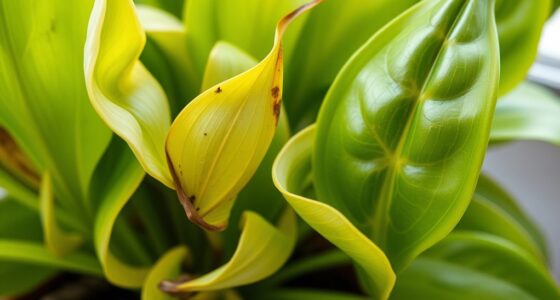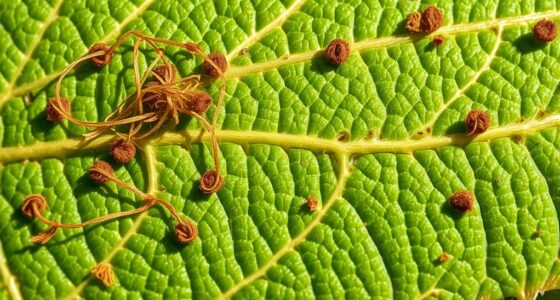If your plant shows yellowing, crispy leaves, wilting, or soft stems, it might be over or underwatered. Soggy soil or a shriveled appearance also indicates watering issues. Look for tiny bugs, webbing, or sticky spots, which point to pests like spider mites or aphids. Clusters of small bumps or cottony masses signal scale or mealybugs. Recognizing these signs early helps you take the right action — learn more to keep your plant healthy.
Key Takeaways
- Observe leaf color, texture, and wilting to identify overwatering, underwatering, or nutrient deficiencies.
- Check soil moisture and drainage to distinguish between soggy or dry soil issues.
- Look for pests like webbing, sticky residue, or bumps to detect infestations.
- Notice signs of stress such as yellowing, browning, or crispy leaves for dehydration or disease.
- Use magnification and proper identification to select effective treatment and prevent further damage.
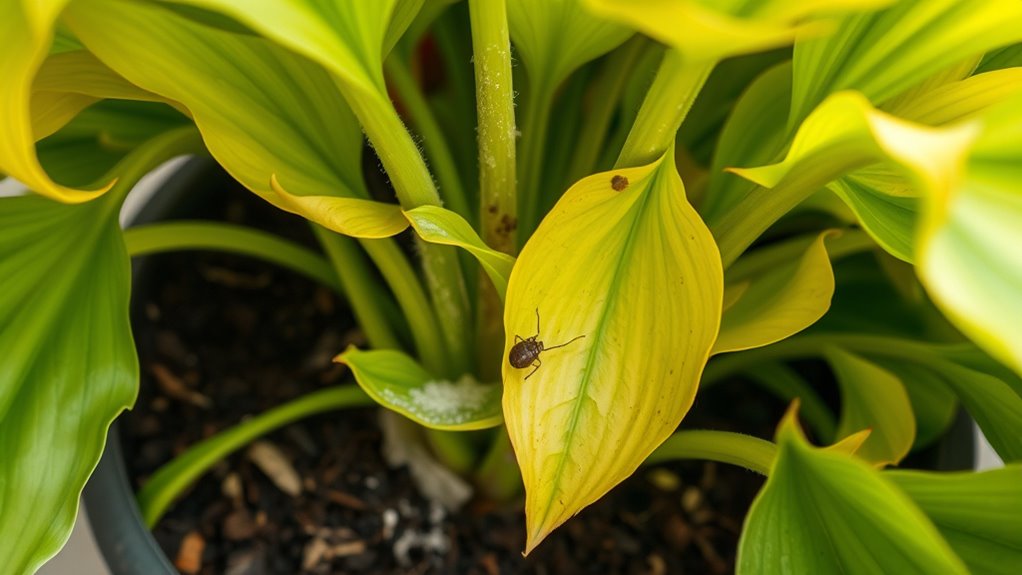
Plants can develop a variety of issues that affect their health and appearance, but many common problems are easy to identify once you know what to look for. The first step is observing your plant carefully and understanding the signs of watering issues and pest identification. Overwatering can cause leaves to yellow, stems to become soft, and roots to rot. You might notice the soil remains soggy long after watering, or the plant appears wilted despite moist soil. Conversely, underwatering leads to dry, crispy leaves, drooping stems, and a general decline in vitality. If the soil feels very dry and the plant looks shriveled, it’s likely suffering from dehydration. Getting the watering right involves checking the soil moisture regularly and adjusting your watering schedule accordingly. Remember, different plants have different needs, so research your specific species to avoid over- or underwatering. Additionally, understanding the industrial juice manufacturing process can help you appreciate the importance of proper handling and preservation of nutrients. Pest identification is equally essential. Tiny insects, webbing, or sticky residue on leaves can signal an infestation. Common pests include spider mites, aphids, mealybugs, and scale insects. Each pest leaves distinct signs; for example, spider mites often produce fine webbing and cause stippled, yellowed leaves, while aphids tend to cluster on new growth and excrete honeydew, which can lead to sooty mold. Mealybugs look like small cottony masses, typically hiding in leaf joints or under stems, and scale insects appear as small, immobile bumps on stems or leaves. If you notice any of these signs, act quickly to identify the pest correctly. Use magnification if needed, and consider natural remedies like neem oil or insecticidal soap to eliminate pests without harming your plant. Proper pest identification helps you choose the most effective treatment and prevents further damage.
Frequently Asked Questions
How Can I Tell if My Plant Needs More Sunlight?
To tell if your plant needs more sunlight, observe its growth and leaf color. If it’s stretching toward light or has pale, dull leaves, it likely needs more light. Plants with proper light requirements usually have vibrant foliage and steady growth. If you notice slow growth or legginess, increase its exposure gradually. Ensuring your plant gets the right amount of sunlight supports healthy growth and keeps it thriving.
What Soil Type Is Best for My Specific Plant?
You should focus on the soil composition that suits your plant’s needs. Check its specific soil requirements because different plants thrive in varying soil types. For example, succulents prefer well-draining sandy soil, while ferns need rich, moisture-retentive soil. To give your plant the best environment, select a plant-specific soil that matches its unique needs, ensuring healthy growth and resilience.
How Often Should I Water Different Types of Houseplants?
You should tailor your watering schedule to each plant’s needs to guarantee proper plant hydration. Some houseplants, like succulents, need infrequent watering, maybe once every few weeks, while others, like ferns, require watering once or twice a week. Check the soil moisture regularly and adjust your watering schedule accordingly. Overwatering can harm your plants, so aim for consistent, appropriate watering to keep them healthy and thriving.
Are Pests Always Visible on the Plant?
Pests aren’t always visible on your plant because they often use pest concealment to hide from your view, making it hard to spot hidden pests. You might not see insects or eggs, but look closely for signs like webbing, holes, or sticky residues. Regularly inspecting your plant helps catch these pests early, even if they’re concealed, so you can take action before serious damage occurs.
When Is the Best Time to Repot My Plant?
You should repot your plant when it outgrows its current container, typically every 1-2 years, or if you notice signs like root rot or fertilizer deficiency. Repot in spring or early summer for best results, giving roots room to grow and fresh soil to address nutrient issues. Doing so helps prevent root rot and boosts overall health, ensuring your plant thrives in its new home.
Conclusion
Understanding your plant’s signs helps you spot issues early and keep it healthy. Did you know that over 70% of houseplant problems stem from improper watering or lighting? By paying close attention to changes in color, growth, or texture, you can troubleshoot quickly and prevent further damage. Staying proactive not only saves your plant but also makes gardening more enjoyable. With a little observation and care, you’ll enjoy thriving, vibrant greenery all year round.
